TRIBUYS GOING OUT OF BUSINESS
Ron Saetermoe
 I received a very sad email yesterday from Cameron and Jennifer of TriBuys – the wonderful store they started in 2007 is closing.
I received a very sad email yesterday from Cameron and Jennifer of TriBuys – the wonderful store they started in 2007 is closing.
It’s a sign of the times unfortunately. Just within the last year we’ve seen four local institutions close: TriBuys, Fleet Feet, Ladera Cyclery and Ciell Cycling. It seems strange that the sport of triathlon is still growing but the businesses that support it are failing left and right.
Personally, I think a lot of triathletes can put off the purchase of a new bike, shoes or a wetsuit but they’ll continue to scrape together the money to race. I know I’m that way. Training and racing are in my blood. Sure, I’d love to get the new Zipp wheels but I’ll put the purchase off another season. I won’t, however, miss IM California 70.3 or IM Arizona!
We will miss all four of these businesses and I wish their owners the best.
Tribuys
11 A. Marconi (near Muirlands & Bake Parkway)
Irvine, CA 92618
949.837.8138
www.tribuys.com
TRIATHICA NOW OPEN 24/7
Ron Saetermoe
 That’s right, Triathica is now open 24 hours a day, 7 days a week!
That’s right, Triathica is now open 24 hours a day, 7 days a week!
We’re excited to bring this new feature to our membership because it gives you the flexibility to workout whenever you want. Please note that we will still have staff hours after February 1st but you should call before coming if you need to meet with a trainer.
So here’s how it will work for current members:
1. Call Ron at 949.795.1900 to arrange to pick up your key.
2. Sign the membership agreement addendum.
3. Come in and workout whenever you want!
New members will receive their personalized key when they enroll and begin using the facility immediately.
Please call if you have any other questions about this exciting new development.
Cheers!
Ron
ADAPTATION PERIOD
Ron Saetermoe
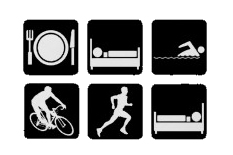
Here at Triathica we prescribe to the concept that your training year should be “periodized.” That simply means that the nature of your workouts will evolve as you get closer to your “A” (most important race of the season) race.
In our model, the first of five periods is called the “adaptation” period. This is the period way out front of your “A” race. It is also the period where you’re just coming back to working out after a hiatus or lull period.
Last year my “A” race was Ironman Arizona. After my big race I cut back on my training and have ignored any semblance of dieting. However, I’ve just completed my fifth week of my adaptation period.
The key things about the adaptation period are:
– You start back to a routine training schedule
– You maintain a light volume of training and moderate intensity
– You may incorporate some cross-training such as roller blading or skiing
– You’re likely to be sore because you’re getting back into your routine again
– You may miss workouts here and there without guilt
Here’s what the ideal Triathica year looks like:
 We feel that three, three-week cycles within each period is optimal for building fitness and recovery. The adaptation period is a necessary step so you can return to your training without injury or sickness.
We feel that three, three-week cycles within each period is optimal for building fitness and recovery. The adaptation period is a necessary step so you can return to your training without injury or sickness.
Cheers!
Ron
RACE REPORT: SOCAL HALF MARATHON
Ron Saetermoe
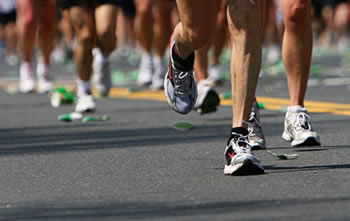 Early season racing is always tough. You’ve probably been overeating and under-training for at least a month. That’s exactly where I was when I did the 2010 SoCal Half Marathon on Sunday, January 9th.
Early season racing is always tough. You’ve probably been overeating and under-training for at least a month. That’s exactly where I was when I did the 2010 SoCal Half Marathon on Sunday, January 9th.
I’m one of those people that like to reward myself when I work especially hard. And since I worked my tail off in preparation for IMAZ I’ve been rewarding myself ever since. As a result I’ve gained six pounds. I’m not beating myself up about it, I’m just sayin.’
Actually, I have been working out. As of race day I had just finished the first four weeks of my 2010 IM training plan and hadn’t tapered for the ½ marathon. I did beat myself up pretty bad the week before and included resistance training and a couple of awesome CompuTrainer sessions (you know the ones where your legs are shaking when you get off your bike).
And while I had no reason to expect a PR (personal record) was in the cards for me, I decided to go hard anyway. Besides, Scott (Scooter) Calendar was going to shoot for 1:30:00 so I figured I’d run with him at his Garmin defined 6:52 mile pace until I blew up.
The race was great with a lot of friends there. The guy I really had to keep my eye on though was Stan Gertler. Stan is older than me but runs like a rabbit. And as it happened, Stan was staged just in front of me and Scooter.
The gun went off and Stan took off. Scott wanted to log the first mile a bit slower than our target rate to ease into a good pace. The first mile was 7:05, just exactly as Scott prescribed.
We started to pick up after that and we nailed a 6:50 pace for the next several miles, still on Stan’s heels. It was getting hard. My breath was labored and my legs were burning but I was going to hang on for all it was worth.
At about mile six I determined I couldn’t hang with Scott any more so I let him go. We waved at each other multiple times throughout the race. While I didn’t actually “blow up” my pace had slowed considerably, but it was “comfortable.” As comfortable as one can be with labored breathing and legs that are on fire!
The miles click by amazingly fast when you quiet your mind. I know Mark Allen really believes in this and I’m not sure if I’m doing it in the prescribed method but I get into a near trance after a while and time goes very quickly.
I hit every water stop other than the first one. This is a little bit of strategy I use. Generally, a lot of racers go out at a pace faster than they can hold so the first aid station, in particular, gets clogged up (I use this same strategy in century rides and SAG stops). After that I take water at every aid station.
No, I don’t drink Gatorade or take gels. I do take gels with me as insurance but I didn’t use any today. The reason is that many people tend to take in more calories than they need while racing. We were taught at our USAT training that the average male has about 3,000 calories in glycogen stores and women have about 2,000. If that were the case, I wouldn’t come close to burning that number of calories so water should be just fine.
Turns out, water was just fine and I managed to maintain a good pace for the entire race. 1:31:43 (7:00) a PR. Think I didn’t celebrate after that? Beer!
Next up, the Palm Springs century ride on Saturday February 13th followed by the San Diego half marathon on Sunday, February 14th. You game?
ANDY’S NEW LEG
Jarrett Pflieger
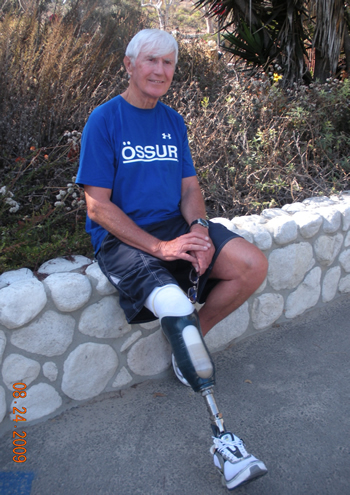 If you are an active part of the triathlon community here in Orange County, you have probably heard of, or even met, Andy Bailey. Andy is actively involved in the community, and can frequently be seen at meetings and functions of the Orange County Triathlon Club, Challenged Athlete Foundation, and more. The fact that Andy is still competing at 71 years old is amazing. The fact that Andy is still competing and is a single leg amputee right below the knee is downright incredible.
If you are an active part of the triathlon community here in Orange County, you have probably heard of, or even met, Andy Bailey. Andy is actively involved in the community, and can frequently be seen at meetings and functions of the Orange County Triathlon Club, Challenged Athlete Foundation, and more. The fact that Andy is still competing at 71 years old is amazing. The fact that Andy is still competing and is a single leg amputee right below the knee is downright incredible.
Andy was seriously injured on December 12, 2006 when a run-away delivery truck slammed into him while washing his car in the driveway. After the accident, he had an ankle fusion and a muscle graft and tried to save the leg for 14 months. Unfortunately it did not heal and he had to have his leg amputated. Since that day, it has been a battle to get back to doing what he loves, competing in triathlon.
Andy’s comeback has included several indoor triathlons with the Triathlon Club of San Diego and the 800-yard ocean swim in the Malibu Triathlon as part of the Challenged Athlete Foundation relay team. He also completed a 1.2 mile swim during the San Diego Triathlon Challenge as part of an Orange County Triathlon Club relay team.
One big part of his comeback has been a company called Ossur, who specializes in making prosthetics for walking and higher performance prosthetics for running.
It seems it was fate that brought the two together. Andy was at the Endurance Sports Awards banquet down in San Diego in 2008. It was right before his amputation that would take place on February 28, 2008. At the time of the banquet, the doctors were still trying to get his surgically repaired ankle to fuse. He was talking about his yearning to compete again, even if he happened to lose his leg. There happened to be the director of education from Ossur, Tabi King, sitting at his table who overheard the conversation. She gave Andy her info and told him to contact her if he needed anything in the future.
The next year, Ossur put on a special amputee running clinic at Soka University in Aliso Viejo. Andy wanted to attend, but didn’t have a run leg yet, so he called Tabi and told her the situation. Ossur was able to have a Flex-run leg ready in time for Andy to do the clinic. NBC even came out and did a news story on Andy and his new leg.
Since then, Andy has been named an Ossur Ambassador and helps promote Ossur products, serves as a model, and helps with occasional PR related activities.
Andy is currently working with Southern California Prosthetics here in Irvine, CA on a new cycling leg, which he has been testing out here at Triathica. The custom liner in this leg has made a huge difference in the healing of the skin from his injury, Andy explained.
Everything seems to be going great and I asked Andy what he was up to now.
“I just sent in my application for the Desert Triathlon Sprint in March. This will be my first individual triathlon since my injury. Then if all goes well, I’ll think about doing the San Diego Sprint Triathlon, Mission Bay, and maybe one of the Bonelli races,” he said.
For now, Andy is working hard to come back and prove, even at 71, you can do anything you put your mind to. In the short term, has his sights set on the Los Alamitos reverse tri where he will be doing the swim portion of the race with a group of other challenged athletes.
HEALTHY FAST FOOD
Kristy Richardson
Do you have a hard time eating healthy because of your busy schedule? For days when you don’t have time to prepare a healthy meal at home, here’s a list of healthy, inexpensive meal options at popular fast food restaurants.
Healthy Fast Food Meals for Under $4
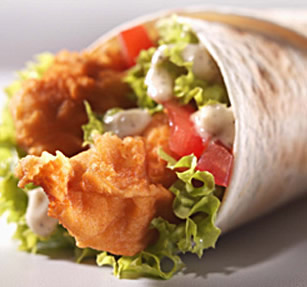
El Pollo Loco
- BRC Burrito and Side of Fresh Vegetables
- Hamburger and Fruit n Yogurt Parfait
- Honey BBQ Sandwich with Green Beans
- Chicken Fajita Pita
- Hamburger with Fruit Cup
430 Calories, 10g Fat, 10g Fiber
McDonald’s
410 Calories, 11g Fat, 2g Fiber
Kentucky Fried Chicken
335 Calories, 4g Fat, 4g Fiber
Jack in the Box
310 Calories, 9.5g Fat, 4g Fiber
370 Calories, 12g Fat, 3g Fiber
Healthy Fast Food Meals for Under $6
- Skinless Chicken Breast, Small Side of Pinto Beans and Small Side of Vegetables
- 6” Sandwich from 6g Fat or Less Menu with a Package of Apple Slices
- Grilled Chicken Classic Sandwich with No Mayo and Apple Slices
- Oven Roasted Twister without Sauce and with Green Beans
- Tender Roast Sandwich without Sauce and with a Small Corn Cob
- Honey BBQ Snacker with Green Beans and a Small Corn Cobb
- Teriyaki Chicken Bowl
- Asian Chicken Salad with Grilled Chicken and Low Fat Chocolate Milk
El Pollo Loco
370 Calories, 4g Fat, 10g Fiber
Subway
265-405 Calories, 3-6g Fat, 7-8g Fiber
McDonald’s
370 Calories, 4.5g Fat, 3g Fiber
KFC
365 Calories, 7g Fat, 4g Fiber
370 Calories, 4.5g Fat, 3g Fiber
305 Calories, 3.5g Fat, 6g Fiber
Jack in the Box
585 Calories, 5.5g Fat, 4g Fiber
365 Calories, 4g Fat, 6.5g Fiber
This information was brought to you by OC Nutrition, Your Trusted Source for Health & Nutrition Advice. OC Nutrition offers nutrition counseling services for Triathica. If you have any questions or would like to schedule an appointment, please contact:
Kristy L. Richardson, MS, MPH, RD, CSSD, CHES
Registered Dietitian & Exercise Physiologist
(949) 933-6788
kristy@ocnutrition.com
www.ocnutrition.com
THE DESERT TRIATHLON
Ron Saetermoe
 One of my favorite races of the year is coming up quickly, March 7th . . . the Desert Triathlon put on by Klein/Clark Sports.
One of my favorite races of the year is coming up quickly, March 7th . . . the Desert Triathlon put on by Klein/Clark Sports.
If you’re not registered for this event and plan to do it, you’d better sign up soon because I’m sure it will fill up and Brenda says the enrollment is way ahead of last year. In fact, they’ve offered Triathica members (you’ve actually got to be a member, not just a newsletter reader) discounts. $10.00 off the International and $5.00 off the Sprint registration.
To register go to www.active.com and use the codes: sprint10 or international10.
This is a great race for newbies and those that don’t like the swim.
I like this race for a number of reasons:
– It’s an early season race, which allows me to clear the competitive cobwebs.
– It’s close. The race takes place in La Quinta, out near Palm Springs.
– The swim is in Lake Cahuilla, which is a water reservoir so there are no large waves or sharks to worry about.
– The bike and run courses are flat. Other than one hill leaving and entering the park it’s completely flat.
– The weather is usually great (it can get windy).
– A lot of people I know compete there.
– There’s a sprint and Olympic race.
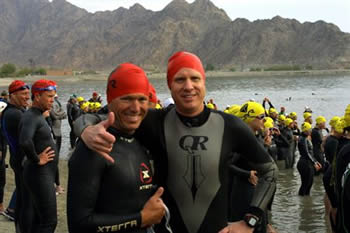
There’s one more reason I like this race and that’s because my pal, Lar Dog Davidson does it every year as well. When we first started competing in this race Larry passed me on the bike early on the second loop. The next year he passed me again on the second loop but later in the race. The next year, later again. Then last year he didn’t catch me until about the first mile on the run. If he races this year I’m hoping to hold him off until at least mile two on the run.
We’ll see . . .
Cheers!
IMPROVE YOUR RUN TIMES THIS SEASON
Jarrett Pflieger
Running off the bike can be a tricky thing to master. Even the best runners on the planet will have a hard time running directly after cycling in a triathlon race. Here are a few tips to help you improve your run times in your next triathlon.
1. Enter running races
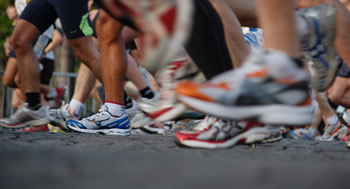 If the only races you do are triathlons, you may be missing out on some serious performance gains. Entering purely running races is a great way to continually test yourself and improve your running performances in triathlon. No matter what we may say, we always work harder in a race than we do in training. Going out and doing a few 5K, 10K, half and full marathons during the year, depending on your race distance, can really help you develop your speed and endurance on the run. You also get more used to the nervousness associated with racing that many people have.
If the only races you do are triathlons, you may be missing out on some serious performance gains. Entering purely running races is a great way to continually test yourself and improve your running performances in triathlon. No matter what we may say, we always work harder in a race than we do in training. Going out and doing a few 5K, 10K, half and full marathons during the year, depending on your race distance, can really help you develop your speed and endurance on the run. You also get more used to the nervousness associated with racing that many people have.
2. Pace yourself
Running after swimming and biking is hard. Running after swimming and biking at full speed without pacing yourself is impossible. To have a good run, you need to save some energy, especially on the bike. Knowing how hard to push it on the bike to get a good time and still have enough for the run is part science and part art form. You need to practice this in order to have your best race possible, which brings us to the next tip.
3. Brick workouts
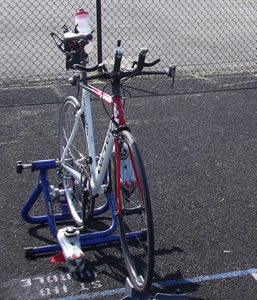 Brick workouts are when you pair two or more exercises together done back-to-back without rest. A very common, and beneficial, brick workout is a bike-run brick. The feeling of running on tired legs is hard to get used to, but brick workouts will help you grow accustomed to and push through the discomfort. Brick workouts also help you determine how fast you can go while still conserving energy for the next leg of the race.
Brick workouts are when you pair two or more exercises together done back-to-back without rest. A very common, and beneficial, brick workout is a bike-run brick. The feeling of running on tired legs is hard to get used to, but brick workouts will help you grow accustomed to and push through the discomfort. Brick workouts also help you determine how fast you can go while still conserving energy for the next leg of the race.
Some people do one large brick every week or every other week. I personally like running a very short distance (one mile or less) after each ride I do, and will do a long run after a bike once a week, maximum. Experiment to see what works best for you.
4. Gain endurance on the bike
It may seem counterintuitive to think about the bike when you are trying to improve your run, but additional endurance on the bike could enable you to run better. Longer bike rides may not make you faster, but they will allow you to feel better and have more energy after riding the same distance at the same speed. Even if you don’t improve your bike times at a certain distance, but do feel and perform better after you ride the distance, it is still a win. Try incorporating some longer rides in your training if you feel your endurance is lacking.
Hopefully these tips will help you become a stronger triathlon runner in 2010. It may be wise to consult a certified coach before attempting any new training program if you are an inexperienced triathlete.
COMING BACK
Ron Saetermoe
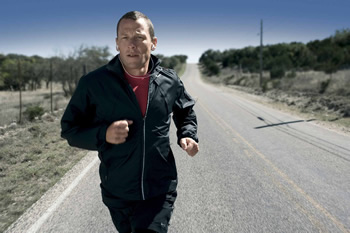 Chances are, if you’re like the majority of triathletes, you haven’t been training much the past several weeks, or months. No, i’m not going to attempt to make you feel guilty for slacking, because I happen to think slacking is good sometimes.
Chances are, if you’re like the majority of triathletes, you haven’t been training much the past several weeks, or months. No, i’m not going to attempt to make you feel guilty for slacking, because I happen to think slacking is good sometimes.
If you think you have to train hard, all of the time, to really perform at your best, you are dead wrong. We all need to give ourselves physical and mental breaks from time to time.
Personally, I’ve still been working out five to six times a week, sometimes twice a day, but most of the efforts have been conservative. After the huge volumes of training leading up to Ironman Arizona I just felt like I needed a break.
The other thing I’ve given myself a break on is my diet. It was my goal to weigh 160 before Ironman Arizona and I reached that goal without sacrificing any strength. And while I’m not generally disciplined with my diet, I did manage to get down to my goal weight.
Since IMAZ, it has been another story. I’ve been eating ice cream, cake and fast food like they’ll be banning it soon. As a result, I’ve gained six pounds since my race. Of course 166 isn’t exactly overweight for a six-foot male, but I definitely feel it.
The one thing I have done is been very disciplined regarding my resistance (strength) training. I’ve been doing two sessions each week for the past three weeks. While I’ve really enjoyed these sessions, I’m also really sore after them. As a result, my other workouts have been compromised because of the muscle soreness.
You have to expect some aches and pains when you reenter the world of triathlon training. The advice here is obvious. Take it slow, and don’t overdo it. On those days when I’m really sore I still try to work out, but will reduce the volume or intensity of these sessions.
For example, last Wednesday I did a very intense hour on the CompuTrainer. While it was really painful, I was so glad I did it. It felt like I still had most of my hard-earned fitness. Later that same day I got on the treadmill with the aim to go another hour. I was fine through the warm-up but just didn’t have “it,” so I stopped after 30 minutes.
So, do I feel guilty for not completing my workout or slacking on my diet? No. If I’m in the same place three weeks from now I’ll be beating myself up for such transgressions, but not now.
It’s a new year and if you’re competing in 2010 it’s time for you to get started. Start back slow. Don’t try to do too much, too soon. If you don’t have “it” on a particular day give yourself a pass. Yes, you’ll want to get very persistent in your training very soon now if you want to have a good season but for now a little slacking is advised.
Cheers!
STAY CONNECTED WITH THE TRIATHLON COMMUNITY
Jarrett Pflieger
One of the great aspects about competing in the sport of triathlon is all the relationships you can form along the way. Training and competing alone is OK, but nothing beats the competitiveness and camaraderie of training and racing with a friend or a group.
Triathlon is a great way to meet new people that share your interests and athletic goals. The social aspect of the sport is what draws many people to it and keeps it growing. Meeting other athletes and staying connected is easier than ever before with all the tools available on the Internet. I’m sure many of you already have a Facebook and Twitter account, but if you don’t, I highly recommend you check them out.

Facebook.com and Twitter.com are great for keeping up with what’s going on in the sport, both locally and abroad. Triathica has accounts with both websites and we routinely send out updates, articles, tips, and announcements that are free to anyone. Aside from joining a local organization like the Orange County Triathlon Club, setting up an account with a social networking website is a great way to connect with other athletes, learn training and racing tips, find training partners, and more.
Check out our Facebook and Twitter posts and create a free account while you are there if you do not have one already. Please introduce yourself; we’d love to meet you.


